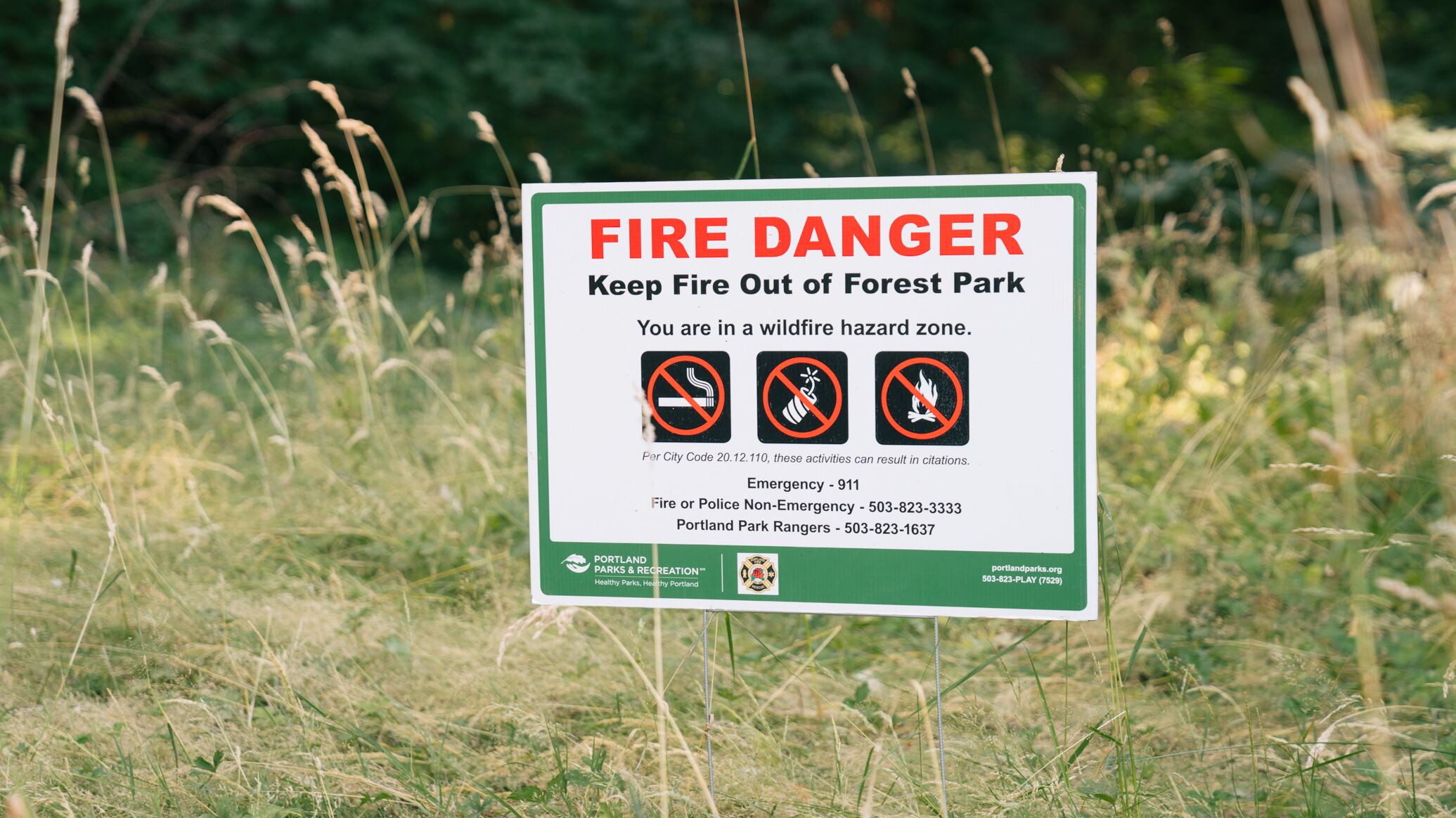As wildfires tear through nearly 450,000 acres of Oregon this week, perhaps you’re feeling grateful to be a city dweller. Don’t be so sure.
Portland officials are increasingly concerned that the city’s showcase park in the West Hills places it at risk for a nightmare scenario: an urban forest fire.
Forest Park stretches for 8 square miles of Douglas firs, elms and cedars along the ridgeline of the Northwest Hills. It’s the largest urban forest in the nation.
But as climate change turns the Pacific Northwest’s natural blessings into liabilities with each bone-dry summer, city emergency officials say Forest Park catching fire is one of the top natural hazards now facing Portland.
The city first identified wildfire in Forest Park as a “mounting” threat a decade ago in its 2009 Wildfire Readiness Assessment. That document noted that fires in Powell Butte and Forest Park were of major concern to the city: “There is an ongoing risk that during a severe drought, park vegetation that is not normally flammable could dry out enough to carry a fire into the forest canopy, where it would be very difficult to bring under control.”
Jonna Papaefthimiou, director of the Portland Bureau of Emergency Management, says the risk has only increased since.
“More than 70,000 residents live in areas that would be directly threatened by a fire there,” she says. “And we know some people camp right in the park and would have no time or ability to evacuate. Furthermore, all Portlanders would be impacted by the smoke and massive disruption a Forest Park fire would cause—even if it were quickly contained. For all these reasons, we consider the fire threat in Forest Park to be one of the highest threats to public safety in our city.”
Kim Kosmas, a senior fire inspector and firefighter with Portland Fire & Rescue, says only earthquakes, flooding and landslides pose a greater threat to Portlanders than a match dropped along the Wildwood Trail.
“It’s definitely at the top of the list. If you look at our wildfire hazard map, it’s basically the West Hills,” says Kosmas. “Forest Park is beautiful and green, but with the right conditions—with winds and drying—it could burn pretty quickly. The trends are changing, and all the scientists are saying it’s going to get worse.”
Erica Nelson, a PF&R captain who patrols the park, describes the worst-case scenario: a source for the fire, an abundance of dry vegetation, heat to sustain the fire, and just one gust of wind to help it travel and spread.
“It’s not a big deal,” she says, “until it is.”
The task of thwarting such a cataclysm falls to Nelson—one of two firefighters in a golf cart.
On the afternoon of July 23, two firefighters from Station 27 on Northwest Skyline Boulevard hopped into their Kawasaki golf cart, which labored up and down the steep trails of Forest Park, spitting fumes.
The cart had few accoutrements: a shovel, water bags that are attachable to special backpacks to put out small fires, and a chainsaw.
Nelson and Tim Gilbert took the cart on one of its standard routes on fire lane paths along Leif Erikson Drive Trail. Firefighters from Station 27 do this patrol every Thursday. Another fire station down the road handles the patrol every Tuesday.
They’re looking for remnants of a camp or stove fire, cigarette butts, and other human-generated fire hazards.
At one point, Gilbert slowed down the golf cart and peered down a hill. He nodded toward a faint outline of a trampled path off the main trail. That’s something else they look for: paths that indicate people may be camping at the end of them and possibly starting warming or cooking fires.
In April, the fire bureau responded to two fires, each about 200 by 200 feet, in Forest Park near the lower part above Highway 30. The fires started in homeless encampments, fire officials say.
Homelessness in Forest Park is hard to track because the park is so large and the greenery hides encampments. But PF&R Capt. Louisa Jones says the homeless population in the park has increased over the years. And 90% of Oregon’s fires are human-caused.
“We have absolutely seen an increase in calls,” Jones says. “If you have 15 people doing 15 fires a day versus one guy doing a fire a day, that’s a 15-fold increase in the risk.”
On July 28, Commissioner Jo Ann Hardesty, who oversees the fire bureau, is set to present the City Council a new protocol to decrease the number of campers in wildfire hazard zones, including Forest Park.
The protocol warns, “Unauthorized camping in our designated wildfire hazard zones poses an unacceptably high threat of potentially catastrophic wildfire incidents.”
The PF&R plan entails a more proactive approach to relocating campers living in high-risk wildfire areas. First, it will send Street Roots staff to urge relocation. If that doesn’t work, it’ll bring in the city’s Homeless and Urban Camping Impact Reduction Program—the group responsible for sweeps.
But homeless camping is only one of three reasons the risk of a Forest Park fire is increasing.
The second is hotter and drier summers that are starting earlier in the year. “You can already see how dry everything is,” Nelson says, pointing at a fern from her passenger’s seat in the golf cart, its tips tinged brown and curling into themselves.
That means fires are popping up earlier in the year, making it more important to trim thickets away from the conifers.
Green vegetation might seem like a deterrent to fire, but the park’s largely unmanaged underbrush often reaches all the way up to the trees, providing more fuel to catch the trees on fire.
“If we don’t clean up the underbrush and you get a big enough fire underneath, that’s when it’s extremely hard to get contained,” says Jones. “We can’t just overcome it with hoses from the ground.”
The third reason a large fire in Forest Park concerns officials: homes threaded along the park’s edge—and filled with toxic material.
Elliott Gall is an assistant professor at Portland State University and air quality researcher who’s studied air pollution from wildfires. “That’s the concern of mine at Forest Park,” Gall says. “If there were a major wildfire in the park, what else would burn in close proximity?”
Building materials create a “more diverse and toxic soup” than just burning trees, he says. “Its proximity to a few million people, that’s a concern.”
The fire bureau is so alarmed by the homes in and surrounding Forest Park that it’s increasing public education about ways to prevent fire from reaching homes in an emergency—like clearing brush away from a home’s perimeter and having an action plan in case of fire.
“A lot of the fires that start are from the embers that find the receptive fuels near gutters or the welcome mat on the front door. If you can imagine a snowstorm, it’s like an ember storm,” Kosmas says.
Quietly, changes to Forest Park management are coming.
Fire officials want to make alterations to city code that would allow homeowners to chop down more trees and clear a wider berth free of vegetation around homes to create natural fire barriers.
Portland General Electric, whose power lines crisscross above Forest Park, is in discussions with the fire bureau to implement a plan to turn off power lines in case of extreme weather conditions. (Fallen power lines in a windstorm sparked some of the worst wildfire damage in Oregon last summer.)
And city officials were recently awarded a $429,000 grant by the Federal Emergency Management Agency to address fire risk in the Linnton neighborhood between the base of Forest Park and the Willamette River.
Kosmas says it’s about time.
“The policies about how to manage the park and natural areas were made 30 years ago, and they need to be brought up to speed,” she says. “Thirty years ago, you’d never think there would be a wildfire here.”

